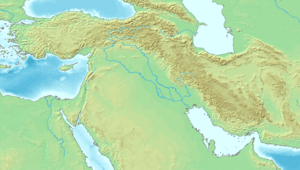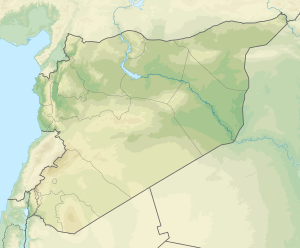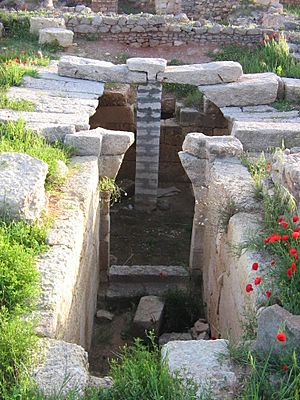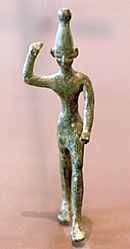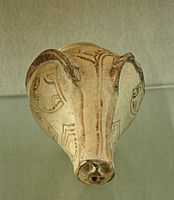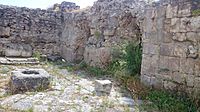Ugarit facts for kids
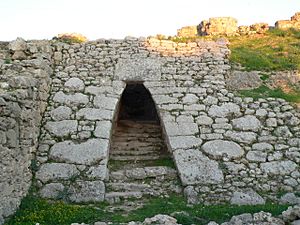
Entrance to the Royal Palace of Ugarit
|
|
| Alternative name | Ras Shamra (Arabic: رأس شمرة) |
|---|---|
| Location | Latakia Governorate, Syria |
| Region | Fertile Crescent |
| Coordinates | 35°36′07″N 35°46′55″E / 35.602°N 35.782°E |
| Type | settlement |
| History | |
| Founded | c. 6000 BC |
| Abandoned | c. 1185 BC |
| Periods | Neolithic–Late Bronze Age |
| Cultures | Canaanite |
| Events | Bronze Age Collapse |
| Site notes | |
| Excavation dates | 1928–present |
| Archaeologists | Claude F. A. Schaeffer |
| Condition | ruins |
| Ownership | Public |
| Public access | Yes |
Ugarit (/juːˈɡɑːrɪt, uː-/; Ugaritic: 𐎜𐎂𐎗𐎚, ʾUgarītu; Arabic: أُوغَارِيت Ūġārīt or أُوجَارِيت Ūǧārīt) was an ancient port city in northern Syria, in the outskirts of modern Latakia, discovered by accident in 1928 with the Ugaritic texts. Its ruins are often called Ras Shamra after the headland where they lie.
Ugarit had close connections to the Hittite Empire, sent tribute to Egypt at times, and maintained trade and diplomatic connections with Cyprus (then called Alashiya), documented in the archives recovered from the site and corroborated by Mycenaean and Cypriot pottery found there. The polity was at its height from c. 1450 BC until its destruction in c. 1185 BC; this destruction was possibly caused by the purported Sea Peoples or internal struggle. The kingdom would be one of the many dismantled during the Bronze Age Collapse.
Contents
History
Ras Shamra lies on the Mediterranean coast, some 11 kilometres (7 mi) north of Latakia, near modern Burj al-Qasab.
Origins and the second millennium
Neolithic Ugarit was important enough to be fortified with a wall early on, perhaps by 6000 BC, though the site is thought to have been inhabited earlier. Ugarit was important perhaps because it was both a port and at the entrance of the inland trade route to the Euphrates and Tigris lands. The city reached its heyday between 1800 and 1200 BC, when it ruled a trade-based coastal kingdom, trading with Egypt, Cyprus, the Aegean, Syria, the Hittites, and much of the eastern Mediterranean.
The first written evidence mentioning the city comes from the nearby city of Ebla, c. 1800 BC. Ugarit passed into the sphere of influence of Egypt, which deeply influenced its art. Evidence of the earliest Ugaritic contact with Egypt (and the first exact dating of Ugaritic civilization) comes from a carnelian bead identified with the Middle Kingdom pharaoh Senusret I, 1971–1926 BC. A stela and a statuette from the Egyptian pharaohs Senusret III and Amenemhet III have also been found. However, it is unclear at what time these monuments were brought to Ugarit. Amarna letters from Ugarit c. 1350 BC record one letter each from Ammittamru I, Niqmaddu II, and his queen. From the 16th to the 13th century BC, Ugarit remained in regular contact with Egypt and Alashiya (Cyprus).
In the second millennium BC, Ugarit's population was Amorite, and the Ugaritic language probably has a direct Amoritic origin. The kingdom of Ugarit may have controlled about 2,000 km2 on average.
During some of its history it would have been in close proximity to, if not directly within, the Hittite Empire.
Destruction
The last Bronze Age king of Ugarit, Ammurapi (circa 1215 to 1180 BC), was a contemporary of the last known Hittite king, Suppiluliuma II. The exact dates of his reign are unknown. However, a letter by the king is preserved, in which Ammurapi stresses the seriousness of the crisis faced by many Near Eastern states due to attacks. Ammurapi's response to an appeal for assistance from the king of Alashiya highlights the desperate situation that Ugarit and other cities faced:
My father, behold, the enemy's ships came (here); my cities(?) were burned, and they did evil things in my country. Does not my father know that all my troops and chariots(?) are in the Land of Hatti, and all my ships are in the Land of Lukka? ... Thus, the country is abandoned to itself. May my father know it: the seven ships of the enemy that came here inflicted much damage upon us.
Eshuwara, the senior governor of Cyprus, responded:
As for the matter concerning those enemies: (it was) the people from your country (and) your own ships (who) did this! And (it was) the people from your country (who) committed these transgression(s) ... I am writing to inform you and protect you. Be aware!
The ruler of Carchemish sent troops to assist Ugarit, but Ugarit had been sacked. A letter sent after Ugarit had been destroyed said:
When your messenger arrived, the army was humiliated and the city was sacked. Our food in the threshing floors was burnt and the vineyards were also destroyed. Our city is sacked. May you know it! May you know it!
By excavating the highest levels of the city's ruins, archaeologists can study various attributes of Ugaritic civilization just before their destruction, and compare artifacts with those of nearby cultures to help establish dates. Ugarit also contained many caches of cuneiform tablets, actual libraries that contained a wealth of information. The destruction levels of the ruin contained Late Helladic IIIB pottery ware, but no LH IIIC (see Mycenaean period). Therefore, the date of the destruction of Ugarit is important for the dating of the LH IIIC phase in mainland Greece. Since an Egyptian sword bearing the name of pharaoh Merneptah was found in the destruction levels, 1190 BC was taken as the date for the beginning of the LH IIIC. A cuneiform tablet found in 1986 shows that Ugarit was destroyed after the death of Merneptah (1203 BC). It is generally agreed that Ugarit had already been destroyed by the eighth year of Ramesses III (1178 BC). Recent radiocarbon work, combined with other historical dates and the eclipse of January 21, 1192, indicates a destruction date between 1192 and 1190 BC.
A large number of arrowheads were recovered from the destruction level. Their typology has not been published as yet.
Kings
| Ruler | Reigned | Comments |
|---|---|---|
| Niqmaddu I | Unknown | First known Ugaritan king, known only from a damaged seal that mentions "Yaqarum, son of Niqmaddu, king of Ugarit". |
| Yaqarum | Unknown | Second known Ugaritan king, known only from a damaged seal that mentions "Yaqarum, son of Niqmaddu, king of Ugarit". |
| Ammittamru I | c. 1350 BC | |
| Niqmaddu II | c. 1350–1315 BC | Contemporary of Suppiluliuma I of the Hittites |
| Arhalba | c. 1315–1313 BC | Contemporary of king Mursili II of the Hittites |
| Niqmepa | c. 1313–1260 BC | Treaty with Mursili II of the Hittites; Son of Niqmadu II |
| Ammittamru II | c. 1260–1235 BC | Contemporary of Bentisina of Amurru; Son of Niqmepa |
| Ibiranu | c. 1235–1225/20 BC | Addressee of the letter of Piha-walwi |
| Niqmaddu III | c. 1225/20 – 1215 BC | |
| Ammurapi | c. 1200 BC | Contemporary of Chancellor Bay of Egypt. Last known ruler of Ugarit. Ugarit is destroyed in his reign. |
Language and literature
Alphabet
Scribes in Ugarit appear to have originated the "Ugaritic alphabet" around 1400 BC: 30 letters, corresponding to sounds, were inscribed on clay tablets. Although they are cuneiform in appearance, the letters bear no relation to Mesopotamian cuneiform signs; instead, they appear to be somehow related to the Egyptian-derived Phoenician alphabet. While the letters show little or no formal similarity to the Phoenician, the standard letter order (seen in the Phoenician alphabet as ʔ, B, G, D, H, W, Z, Ḥ, Ṭ, Y, K, L, M, N, S, ʕ, P, Ṣ, Q, R, ʃ) shows strong similarities between the two, suggesting that the Phoenician and Ugaritic systems were not wholly independent inventions.
Ugaritic language
The existence of the Ugaritic language is attested to in texts from the 14th through the 12th century BC. Ugaritic is usually classified as a Northwest Semitic language and therefore related to Hebrew, Aramaic, and Phoenician, among others. Its grammatical features are highly similar to those found in Classical Arabic and Akkadian. It possesses two genders (masculine and feminine), three cases for nouns and adjectives (nominative, accusative, and genitive); three numbers: (singular, dual, and plural); and verb aspects similar to those found in other Northwest Semitic languages. The word order in Ugaritic is verb–subject–object, subject-object-verb (VSO)&(SOV); possessed–possessor (NG) (first element dependent on the function and second always in genitive case); and noun–adjective (NA) (both in the same case (i.e. congruent)).
Ugaritic literature
Apart from royal correspondence with neighboring Bronze Age monarchs, Ugaritic literature from tablets found in the city's libraries include mythological texts written in a poetic narrative, letters, legal documents such as land transfers, a few international treaties, and a number of administrative lists. Fragments of several poetic works have been identified: the "Legend of Keret", the "Legend of Danel", the Ba'al tales that detail Baal-Hadad's conflicts with Yam and Mot, among other fragments.
The discovery of the Ugaritic archives in 1929 has been of great significance to biblical scholarship, as these archives for the first time provided a detailed description of Canaanite religious beliefs, during the period directly preceding the Israelite settlement. These texts show significant parallels to Hebrew biblical literature, particularly in the areas of divine imagery and poetic form. Ugaritic poetry has many elements later found in Hebrew poetry: parallelisms, metres, and rhythms. The discoveries at Ugarit have led to a new appraisal of the Hebrew Bible as literature.
Religion
The important textual finds from the site shed a great deal of light upon the cultic life of the city.
The foundations of the Bronze Age city Ugarit were divided into quarters. In the north-east quarter of the walled enclosure, the remains of three significant religious buildings were discovered, including two temples (of the gods Baal Hadad and Dagon) and a building referred to as the library or the high priest's house. Within these structures atop the acropolis numerous invaluable mythological texts were found. These texts have provided the basis for understanding of the Canaanite mythological world and religion. The Baal of Ugarit was likely the same as the Baal of the Hebrew Bible. The Baal cycle represents Baal Hadad's destruction of Yam (the god of chaos and the sea), demonstrating the relationship of Canaanite chaoskampf with those of Mesopotamia and the Aegean: a warrior god rises up as the hero of the new pantheon to defeat chaos and bring order.
Archaeology
Discovery
After its destruction in the early 12th century BC, Ugarit's location was forgotten until 1928 when a peasant accidentally opened an old tomb while ploughing a field. The discovered area was the necropolis of Ugarit located in the nearby seaport of Minet el-Beida. Excavations have since revealed a city with a prehistory reaching back to c. 6000 BC.
Site and palace
The site is a 20m (65 foot) high mound. Archaeologically, Ugarit is considered quintessentially Canaanite. A brief investigation of a looted tomb at the necropolis of Minet el-Beida was conducted by Léon Albanèse in 1928, who then examined the main mound of Ras Shamra. But in the next year scientific excavations of Tell Ras Shamra were commenced by archaeologist Claude Schaeffer from the Musée archéologique in Strasbourg. Work continued under Schaeffer until 1970, with a break from 1940 to 1947 because of World War II.
The excavations uncovered a royal palace of ninety rooms laid out around eight enclosed courtyards, and many ambitious private dwellings. Crowning the hill where the city was built were two main temples: one to Baal the "king", son of El, and one to Dagon, the chthonic god of fertility and wheat. 23 stelae were unearthed: nine stelae, including the famous Baal with Thunderbolt, near the Temple of Baal, four in the Temple of Dagon and ten more at scattered places around the city.
Texts
On excavation of the site, several deposits of cuneiform clay tablets were found. These have proven to be of great historical significance.
See also
 In Spanish: Ugarit para niños
In Spanish: Ugarit para niños
- Asherah
- Cities of the ancient Near East
- Elohim (gods)
- Short chronology timeline
- Ugaritic mythology


